Pret a Manger Case Study: Financials, SWOT, and Marketing Analysis
VerifiedAdded on 2020/04/15
|23
|7182
|186
Case Study
AI Summary
This case study analyzes Pret a Manger, a prominent British sandwich chain, examining its introduction, background, and strategic initiatives. It delves into the company's financial performance, including revenue, gross profits, and EBIT, offering a comprehensive SWOT analysis to evaluate its strengths, weaknesses, opportunities, and threats. The study further explores Pret a Manger's marketing strategies, including the 7Ps marketing mix, Ansoff matrix, and PESTLE analysis, alongside strategic management tools such as Porter's generic strategies, the blue ocean strategy, and the BCG matrix. The analysis provides insights into the company's operations, problems, and proposed solutions, culminating in a conclusion and references to support the findings. The case study examines Pret a Manger's organizational structure, mission, aims, and objectives within the competitive fast food industry, highlighting its efforts in innovation, customer satisfaction, and market expansion. This case study covers all the key aspects of the business development of Pret a Manger.
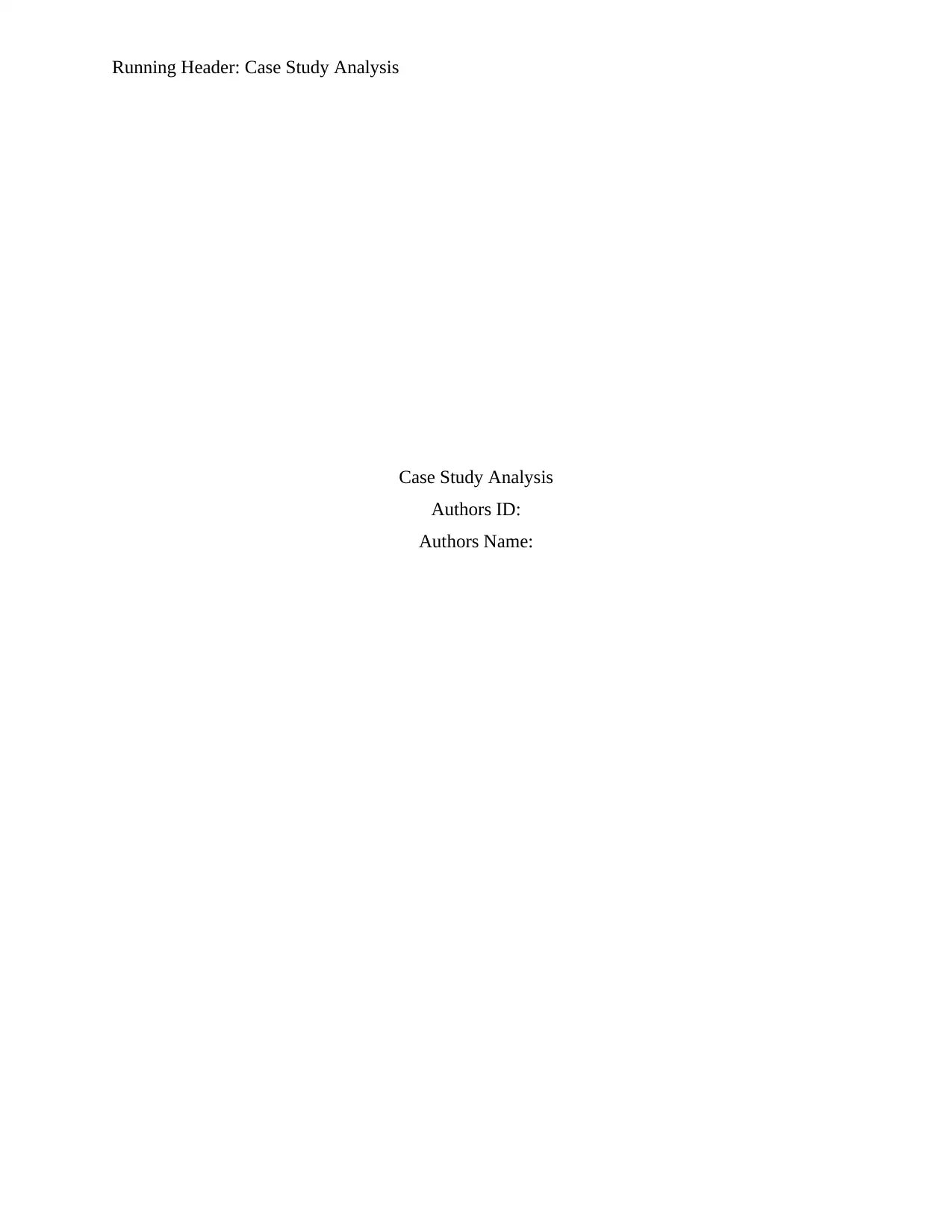
Running Header: Case Study Analysis
Case Study Analysis
Authors ID:
Authors Name:
Case Study Analysis
Authors ID:
Authors Name:
Paraphrase This Document
Need a fresh take? Get an instant paraphrase of this document with our AI Paraphraser
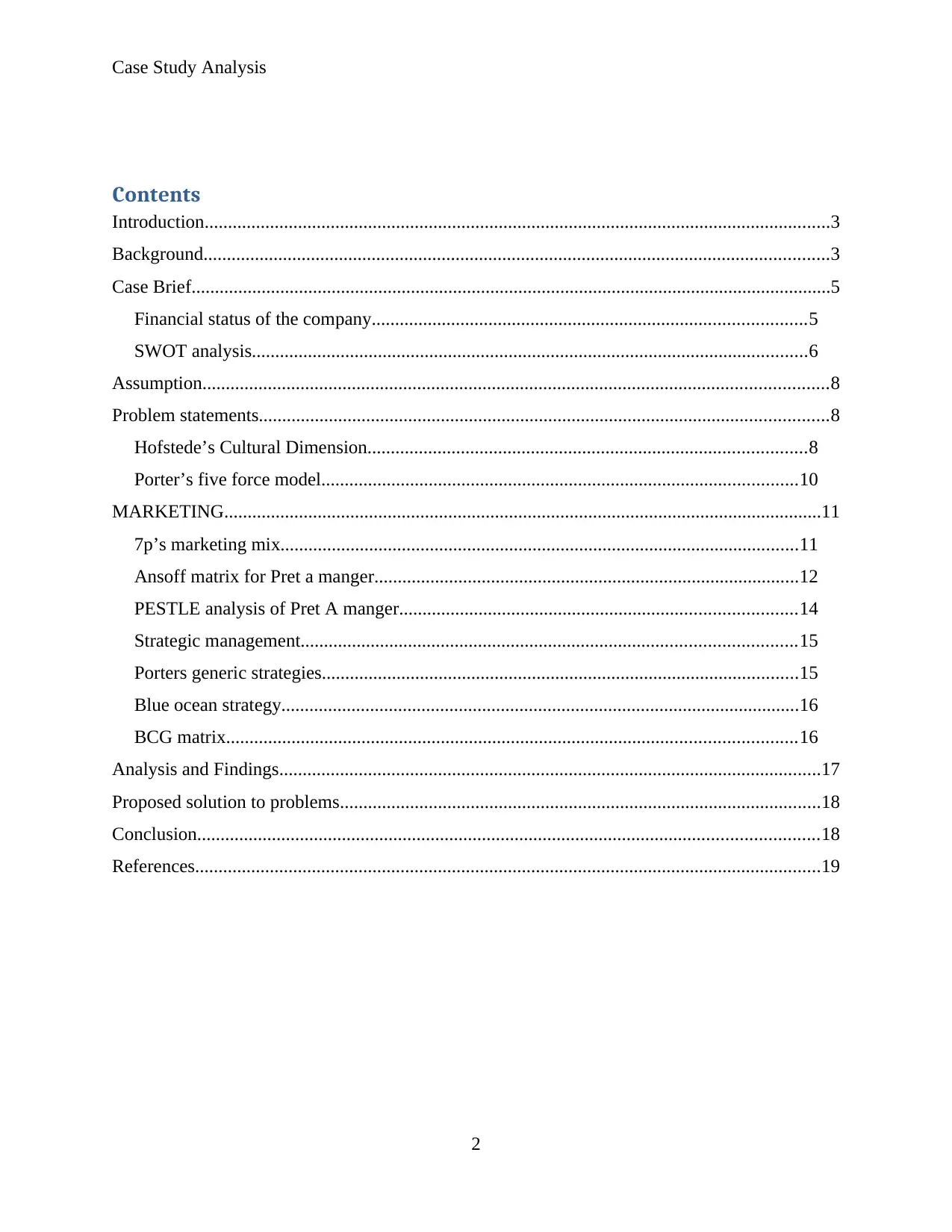
Case Study Analysis
Contents
Introduction......................................................................................................................................3
Background......................................................................................................................................3
Case Brief.........................................................................................................................................5
Financial status of the company.............................................................................................5
SWOT analysis.......................................................................................................................6
Assumption......................................................................................................................................8
Problem statements..........................................................................................................................8
Hofstede’s Cultural Dimension..............................................................................................8
Porter’s five force model......................................................................................................10
MARKETING................................................................................................................................11
7p’s marketing mix...............................................................................................................11
Ansoff matrix for Pret a manger...........................................................................................12
PESTLE analysis of Pret A manger.....................................................................................14
Strategic management..........................................................................................................15
Porters generic strategies......................................................................................................15
Blue ocean strategy...............................................................................................................16
BCG matrix..........................................................................................................................16
Analysis and Findings....................................................................................................................17
Proposed solution to problems.......................................................................................................18
Conclusion.....................................................................................................................................18
References......................................................................................................................................19
2
Contents
Introduction......................................................................................................................................3
Background......................................................................................................................................3
Case Brief.........................................................................................................................................5
Financial status of the company.............................................................................................5
SWOT analysis.......................................................................................................................6
Assumption......................................................................................................................................8
Problem statements..........................................................................................................................8
Hofstede’s Cultural Dimension..............................................................................................8
Porter’s five force model......................................................................................................10
MARKETING................................................................................................................................11
7p’s marketing mix...............................................................................................................11
Ansoff matrix for Pret a manger...........................................................................................12
PESTLE analysis of Pret A manger.....................................................................................14
Strategic management..........................................................................................................15
Porters generic strategies......................................................................................................15
Blue ocean strategy...............................................................................................................16
BCG matrix..........................................................................................................................16
Analysis and Findings....................................................................................................................17
Proposed solution to problems.......................................................................................................18
Conclusion.....................................................................................................................................18
References......................................................................................................................................19
2
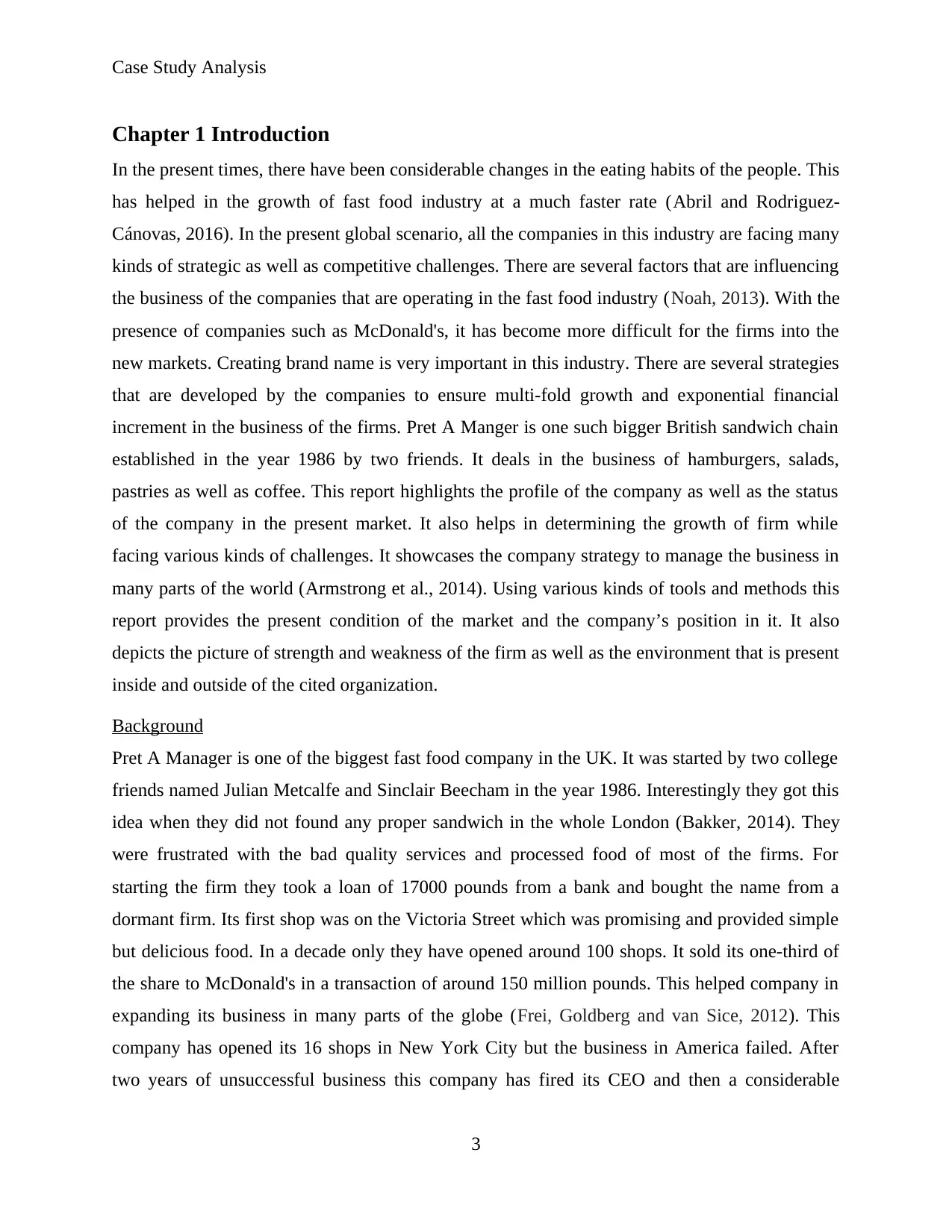
Case Study Analysis
Chapter 1 Introduction
In the present times, there have been considerable changes in the eating habits of the people. This
has helped in the growth of fast food industry at a much faster rate (Abril and Rodriguez-
Cánovas, 2016). In the present global scenario, all the companies in this industry are facing many
kinds of strategic as well as competitive challenges. There are several factors that are influencing
the business of the companies that are operating in the fast food industry (Noah, 2013). With the
presence of companies such as McDonald's, it has become more difficult for the firms into the
new markets. Creating brand name is very important in this industry. There are several strategies
that are developed by the companies to ensure multi-fold growth and exponential financial
increment in the business of the firms. Pret A Manger is one such bigger British sandwich chain
established in the year 1986 by two friends. It deals in the business of hamburgers, salads,
pastries as well as coffee. This report highlights the profile of the company as well as the status
of the company in the present market. It also helps in determining the growth of firm while
facing various kinds of challenges. It showcases the company strategy to manage the business in
many parts of the world (Armstrong et al., 2014). Using various kinds of tools and methods this
report provides the present condition of the market and the company’s position in it. It also
depicts the picture of strength and weakness of the firm as well as the environment that is present
inside and outside of the cited organization.
Background
Pret A Manager is one of the biggest fast food company in the UK. It was started by two college
friends named Julian Metcalfe and Sinclair Beecham in the year 1986. Interestingly they got this
idea when they did not found any proper sandwich in the whole London (Bakker, 2014). They
were frustrated with the bad quality services and processed food of most of the firms. For
starting the firm they took a loan of 17000 pounds from a bank and bought the name from a
dormant firm. Its first shop was on the Victoria Street which was promising and provided simple
but delicious food. In a decade only they have opened around 100 shops. It sold its one-third of
the share to McDonald's in a transaction of around 150 million pounds. This helped company in
expanding its business in many parts of the globe (Frei, Goldberg and van Sice, 2012). This
company has opened its 16 shops in New York City but the business in America failed. After
two years of unsuccessful business this company has fired its CEO and then a considerable
3
Chapter 1 Introduction
In the present times, there have been considerable changes in the eating habits of the people. This
has helped in the growth of fast food industry at a much faster rate (Abril and Rodriguez-
Cánovas, 2016). In the present global scenario, all the companies in this industry are facing many
kinds of strategic as well as competitive challenges. There are several factors that are influencing
the business of the companies that are operating in the fast food industry (Noah, 2013). With the
presence of companies such as McDonald's, it has become more difficult for the firms into the
new markets. Creating brand name is very important in this industry. There are several strategies
that are developed by the companies to ensure multi-fold growth and exponential financial
increment in the business of the firms. Pret A Manger is one such bigger British sandwich chain
established in the year 1986 by two friends. It deals in the business of hamburgers, salads,
pastries as well as coffee. This report highlights the profile of the company as well as the status
of the company in the present market. It also helps in determining the growth of firm while
facing various kinds of challenges. It showcases the company strategy to manage the business in
many parts of the world (Armstrong et al., 2014). Using various kinds of tools and methods this
report provides the present condition of the market and the company’s position in it. It also
depicts the picture of strength and weakness of the firm as well as the environment that is present
inside and outside of the cited organization.
Background
Pret A Manager is one of the biggest fast food company in the UK. It was started by two college
friends named Julian Metcalfe and Sinclair Beecham in the year 1986. Interestingly they got this
idea when they did not found any proper sandwich in the whole London (Bakker, 2014). They
were frustrated with the bad quality services and processed food of most of the firms. For
starting the firm they took a loan of 17000 pounds from a bank and bought the name from a
dormant firm. Its first shop was on the Victoria Street which was promising and provided simple
but delicious food. In a decade only they have opened around 100 shops. It sold its one-third of
the share to McDonald's in a transaction of around 150 million pounds. This helped company in
expanding its business in many parts of the globe (Frei, Goldberg and van Sice, 2012). This
company has opened its 16 shops in New York City but the business in America failed. After
two years of unsuccessful business this company has fired its CEO and then a considerable
3
⊘ This is a preview!⊘
Do you want full access?
Subscribe today to unlock all pages.

Trusted by 1+ million students worldwide
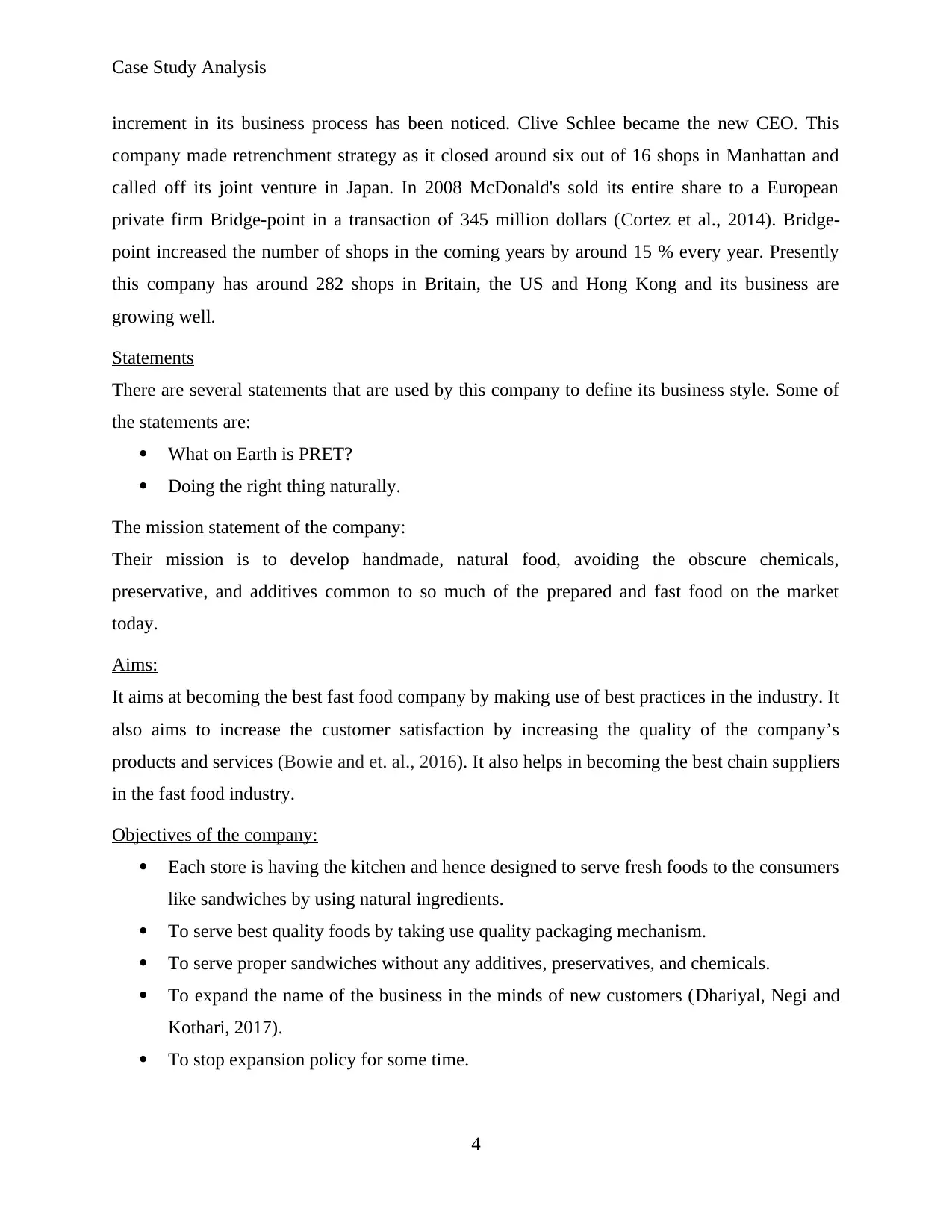
Case Study Analysis
increment in its business process has been noticed. Clive Schlee became the new CEO. This
company made retrenchment strategy as it closed around six out of 16 shops in Manhattan and
called off its joint venture in Japan. In 2008 McDonald's sold its entire share to a European
private firm Bridge-point in a transaction of 345 million dollars (Cortez et al., 2014). Bridge-
point increased the number of shops in the coming years by around 15 % every year. Presently
this company has around 282 shops in Britain, the US and Hong Kong and its business are
growing well.
Statements
There are several statements that are used by this company to define its business style. Some of
the statements are:
What on Earth is PRET?
Doing the right thing naturally.
The mission statement of the company:
Their mission is to develop handmade, natural food, avoiding the obscure chemicals,
preservative, and additives common to so much of the prepared and fast food on the market
today.
Aims:
It aims at becoming the best fast food company by making use of best practices in the industry. It
also aims to increase the customer satisfaction by increasing the quality of the company’s
products and services (Bowie and et. al., 2016). It also helps in becoming the best chain suppliers
in the fast food industry.
Objectives of the company:
Each store is having the kitchen and hence designed to serve fresh foods to the consumers
like sandwiches by using natural ingredients.
To serve best quality foods by taking use quality packaging mechanism.
To serve proper sandwiches without any additives, preservatives, and chemicals.
To expand the name of the business in the minds of new customers (Dhariyal, Negi and
Kothari, 2017).
To stop expansion policy for some time.
4
increment in its business process has been noticed. Clive Schlee became the new CEO. This
company made retrenchment strategy as it closed around six out of 16 shops in Manhattan and
called off its joint venture in Japan. In 2008 McDonald's sold its entire share to a European
private firm Bridge-point in a transaction of 345 million dollars (Cortez et al., 2014). Bridge-
point increased the number of shops in the coming years by around 15 % every year. Presently
this company has around 282 shops in Britain, the US and Hong Kong and its business are
growing well.
Statements
There are several statements that are used by this company to define its business style. Some of
the statements are:
What on Earth is PRET?
Doing the right thing naturally.
The mission statement of the company:
Their mission is to develop handmade, natural food, avoiding the obscure chemicals,
preservative, and additives common to so much of the prepared and fast food on the market
today.
Aims:
It aims at becoming the best fast food company by making use of best practices in the industry. It
also aims to increase the customer satisfaction by increasing the quality of the company’s
products and services (Bowie and et. al., 2016). It also helps in becoming the best chain suppliers
in the fast food industry.
Objectives of the company:
Each store is having the kitchen and hence designed to serve fresh foods to the consumers
like sandwiches by using natural ingredients.
To serve best quality foods by taking use quality packaging mechanism.
To serve proper sandwiches without any additives, preservatives, and chemicals.
To expand the name of the business in the minds of new customers (Dhariyal, Negi and
Kothari, 2017).
To stop expansion policy for some time.
4
Paraphrase This Document
Need a fresh take? Get an instant paraphrase of this document with our AI Paraphraser
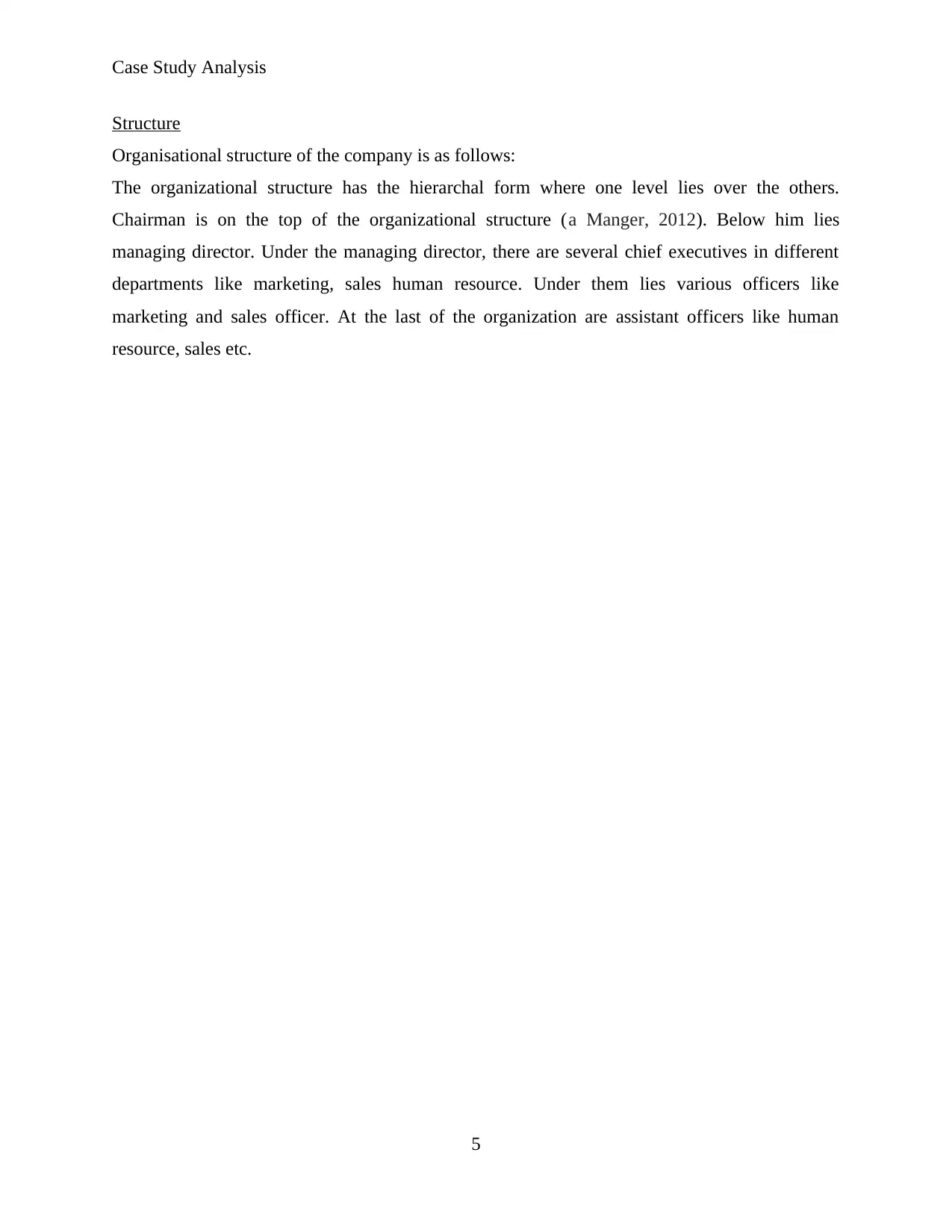
Case Study Analysis
Structure
Organisational structure of the company is as follows:
The organizational structure has the hierarchal form where one level lies over the others.
Chairman is on the top of the organizational structure (a Manger, 2012). Below him lies
managing director. Under the managing director, there are several chief executives in different
departments like marketing, sales human resource. Under them lies various officers like
marketing and sales officer. At the last of the organization are assistant officers like human
resource, sales etc.
5
Structure
Organisational structure of the company is as follows:
The organizational structure has the hierarchal form where one level lies over the others.
Chairman is on the top of the organizational structure (a Manger, 2012). Below him lies
managing director. Under the managing director, there are several chief executives in different
departments like marketing, sales human resource. Under them lies various officers like
marketing and sales officer. At the last of the organization are assistant officers like human
resource, sales etc.
5
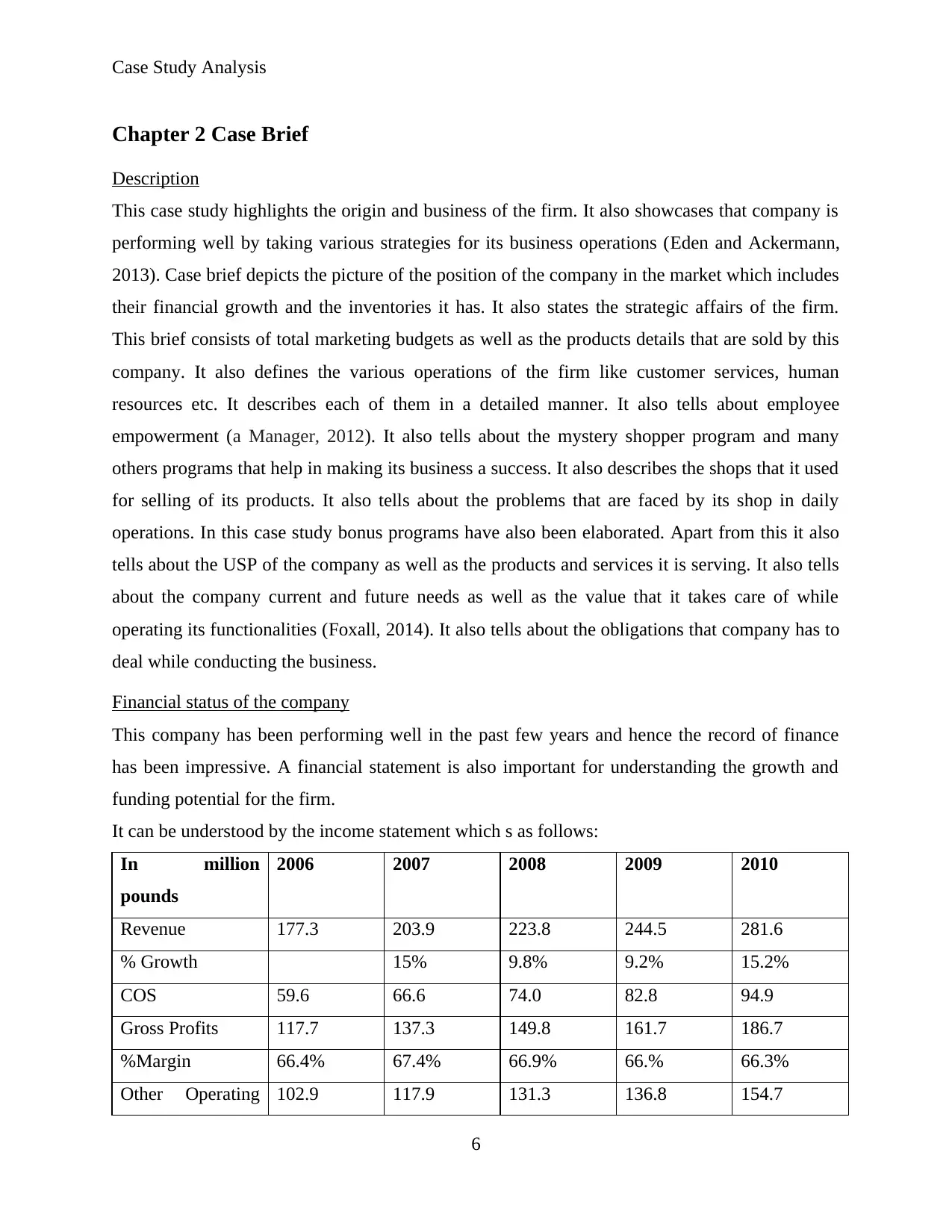
Case Study Analysis
Chapter 2 Case Brief
Description
This case study highlights the origin and business of the firm. It also showcases that company is
performing well by taking various strategies for its business operations (Eden and Ackermann,
2013). Case brief depicts the picture of the position of the company in the market which includes
their financial growth and the inventories it has. It also states the strategic affairs of the firm.
This brief consists of total marketing budgets as well as the products details that are sold by this
company. It also defines the various operations of the firm like customer services, human
resources etc. It describes each of them in a detailed manner. It also tells about employee
empowerment (a Manager, 2012). It also tells about the mystery shopper program and many
others programs that help in making its business a success. It also describes the shops that it used
for selling of its products. It also tells about the problems that are faced by its shop in daily
operations. In this case study bonus programs have also been elaborated. Apart from this it also
tells about the USP of the company as well as the products and services it is serving. It also tells
about the company current and future needs as well as the value that it takes care of while
operating its functionalities (Foxall, 2014). It also tells about the obligations that company has to
deal while conducting the business.
Financial status of the company
This company has been performing well in the past few years and hence the record of finance
has been impressive. A financial statement is also important for understanding the growth and
funding potential for the firm.
It can be understood by the income statement which s as follows:
In million
pounds
2006 2007 2008 2009 2010
Revenue 177.3 203.9 223.8 244.5 281.6
% Growth 15% 9.8% 9.2% 15.2%
COS 59.6 66.6 74.0 82.8 94.9
Gross Profits 117.7 137.3 149.8 161.7 186.7
%Margin 66.4% 67.4% 66.9% 66.% 66.3%
Other Operating 102.9 117.9 131.3 136.8 154.7
6
Chapter 2 Case Brief
Description
This case study highlights the origin and business of the firm. It also showcases that company is
performing well by taking various strategies for its business operations (Eden and Ackermann,
2013). Case brief depicts the picture of the position of the company in the market which includes
their financial growth and the inventories it has. It also states the strategic affairs of the firm.
This brief consists of total marketing budgets as well as the products details that are sold by this
company. It also defines the various operations of the firm like customer services, human
resources etc. It describes each of them in a detailed manner. It also tells about employee
empowerment (a Manager, 2012). It also tells about the mystery shopper program and many
others programs that help in making its business a success. It also describes the shops that it used
for selling of its products. It also tells about the problems that are faced by its shop in daily
operations. In this case study bonus programs have also been elaborated. Apart from this it also
tells about the USP of the company as well as the products and services it is serving. It also tells
about the company current and future needs as well as the value that it takes care of while
operating its functionalities (Foxall, 2014). It also tells about the obligations that company has to
deal while conducting the business.
Financial status of the company
This company has been performing well in the past few years and hence the record of finance
has been impressive. A financial statement is also important for understanding the growth and
funding potential for the firm.
It can be understood by the income statement which s as follows:
In million
pounds
2006 2007 2008 2009 2010
Revenue 177.3 203.9 223.8 244.5 281.6
% Growth 15% 9.8% 9.2% 15.2%
COS 59.6 66.6 74.0 82.8 94.9
Gross Profits 117.7 137.3 149.8 161.7 186.7
%Margin 66.4% 67.4% 66.9% 66.% 66.3%
Other Operating 102.9 117.9 131.3 136.8 154.7
6
⊘ This is a preview!⊘
Do you want full access?
Subscribe today to unlock all pages.

Trusted by 1+ million students worldwide
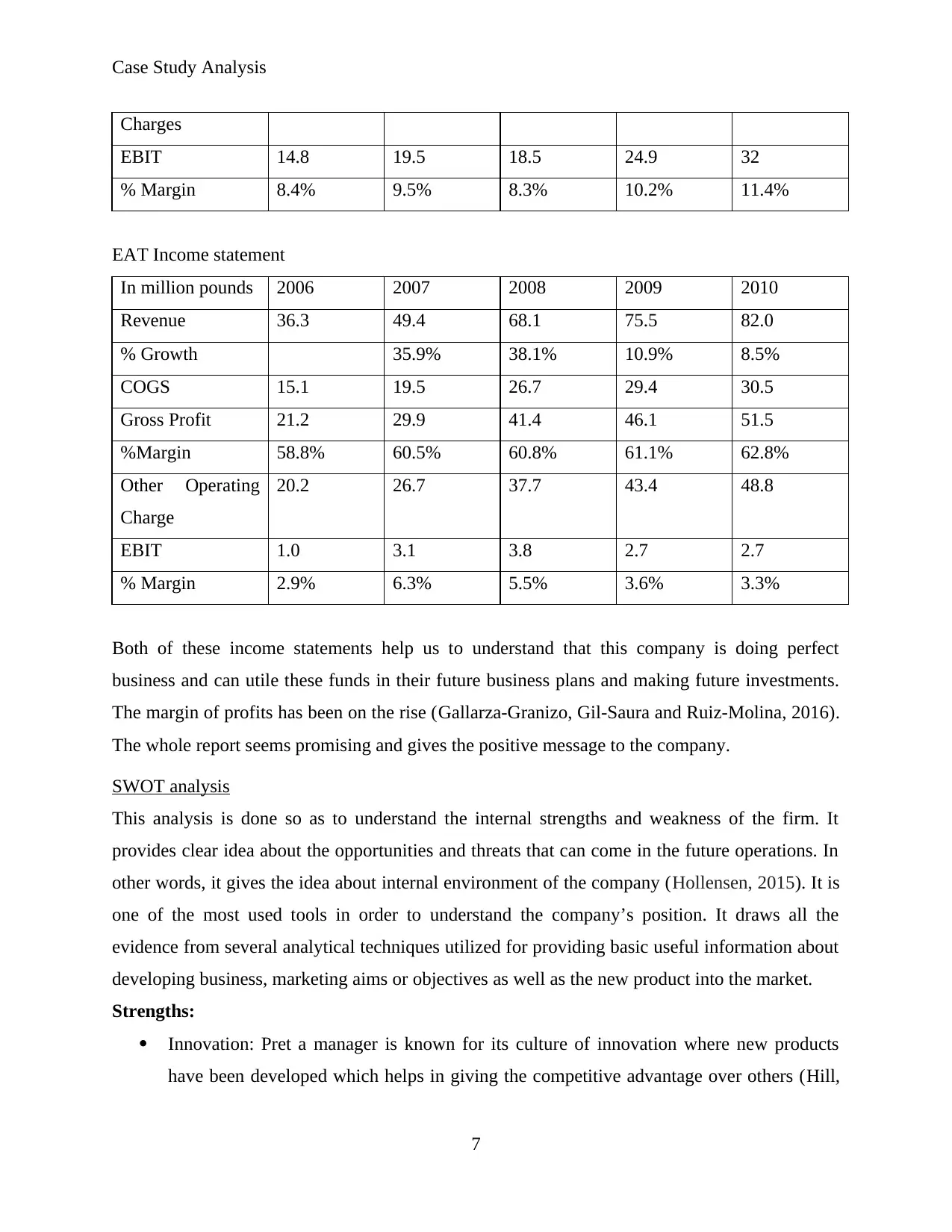
Case Study Analysis
Charges
EBIT 14.8 19.5 18.5 24.9 32
% Margin 8.4% 9.5% 8.3% 10.2% 11.4%
EAT Income statement
In million pounds 2006 2007 2008 2009 2010
Revenue 36.3 49.4 68.1 75.5 82.0
% Growth 35.9% 38.1% 10.9% 8.5%
COGS 15.1 19.5 26.7 29.4 30.5
Gross Profit 21.2 29.9 41.4 46.1 51.5
%Margin 58.8% 60.5% 60.8% 61.1% 62.8%
Other Operating
Charge
20.2 26.7 37.7 43.4 48.8
EBIT 1.0 3.1 3.8 2.7 2.7
% Margin 2.9% 6.3% 5.5% 3.6% 3.3%
Both of these income statements help us to understand that this company is doing perfect
business and can utile these funds in their future business plans and making future investments.
The margin of profits has been on the rise (Gallarza-Granizo, Gil-Saura and Ruiz-Molina, 2016).
The whole report seems promising and gives the positive message to the company.
SWOT analysis
This analysis is done so as to understand the internal strengths and weakness of the firm. It
provides clear idea about the opportunities and threats that can come in the future operations. In
other words, it gives the idea about internal environment of the company (Hollensen, 2015). It is
one of the most used tools in order to understand the company’s position. It draws all the
evidence from several analytical techniques utilized for providing basic useful information about
developing business, marketing aims or objectives as well as the new product into the market.
Strengths:
Innovation: Pret a manager is known for its culture of innovation where new products
have been developed which helps in giving the competitive advantage over others (Hill,
7
Charges
EBIT 14.8 19.5 18.5 24.9 32
% Margin 8.4% 9.5% 8.3% 10.2% 11.4%
EAT Income statement
In million pounds 2006 2007 2008 2009 2010
Revenue 36.3 49.4 68.1 75.5 82.0
% Growth 35.9% 38.1% 10.9% 8.5%
COGS 15.1 19.5 26.7 29.4 30.5
Gross Profit 21.2 29.9 41.4 46.1 51.5
%Margin 58.8% 60.5% 60.8% 61.1% 62.8%
Other Operating
Charge
20.2 26.7 37.7 43.4 48.8
EBIT 1.0 3.1 3.8 2.7 2.7
% Margin 2.9% 6.3% 5.5% 3.6% 3.3%
Both of these income statements help us to understand that this company is doing perfect
business and can utile these funds in their future business plans and making future investments.
The margin of profits has been on the rise (Gallarza-Granizo, Gil-Saura and Ruiz-Molina, 2016).
The whole report seems promising and gives the positive message to the company.
SWOT analysis
This analysis is done so as to understand the internal strengths and weakness of the firm. It
provides clear idea about the opportunities and threats that can come in the future operations. In
other words, it gives the idea about internal environment of the company (Hollensen, 2015). It is
one of the most used tools in order to understand the company’s position. It draws all the
evidence from several analytical techniques utilized for providing basic useful information about
developing business, marketing aims or objectives as well as the new product into the market.
Strengths:
Innovation: Pret a manager is known for its culture of innovation where new products
have been developed which helps in giving the competitive advantage over others (Hill,
7
Paraphrase This Document
Need a fresh take? Get an instant paraphrase of this document with our AI Paraphraser
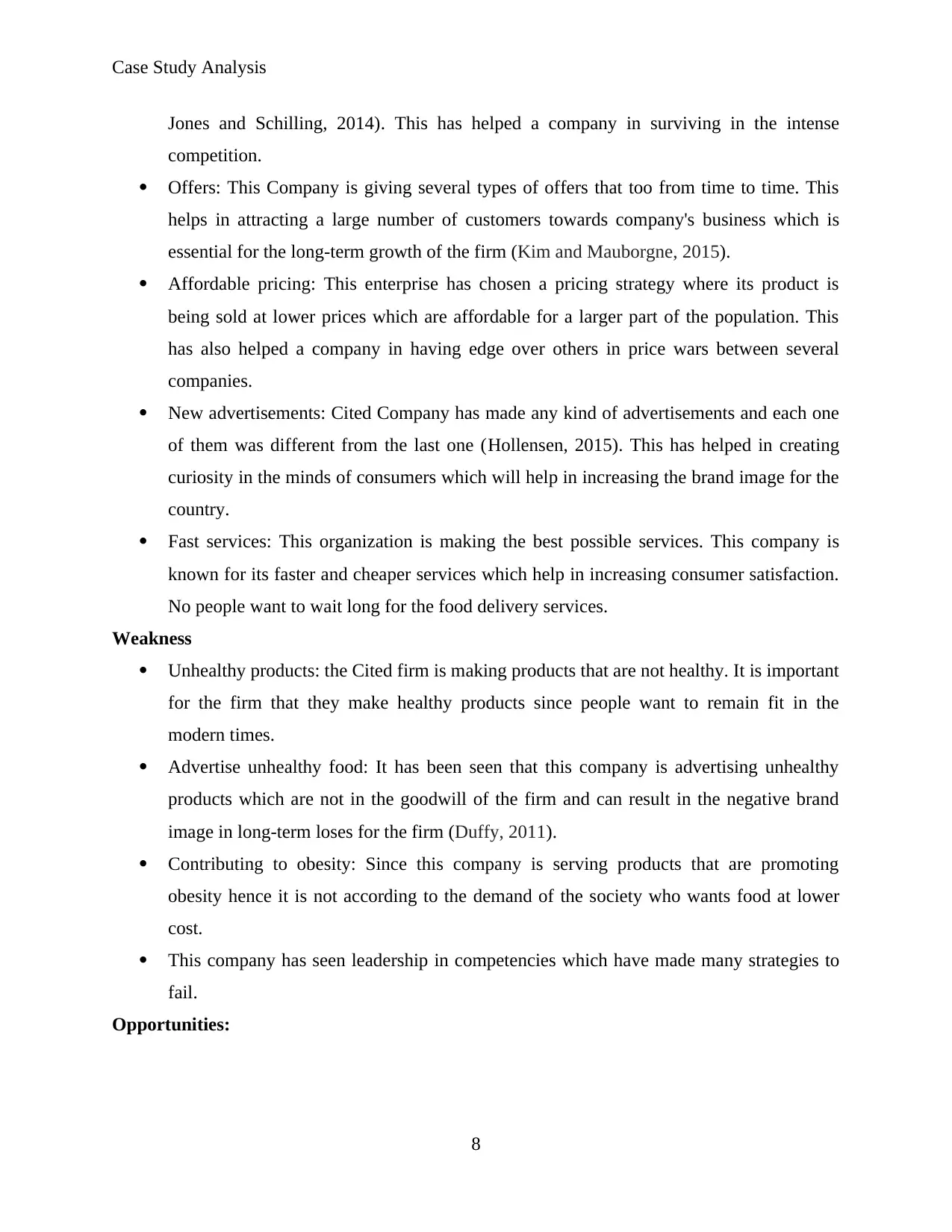
Case Study Analysis
Jones and Schilling, 2014). This has helped a company in surviving in the intense
competition.
Offers: This Company is giving several types of offers that too from time to time. This
helps in attracting a large number of customers towards company's business which is
essential for the long-term growth of the firm (Kim and Mauborgne, 2015).
Affordable pricing: This enterprise has chosen a pricing strategy where its product is
being sold at lower prices which are affordable for a larger part of the population. This
has also helped a company in having edge over others in price wars between several
companies.
New advertisements: Cited Company has made any kind of advertisements and each one
of them was different from the last one (Hollensen, 2015). This has helped in creating
curiosity in the minds of consumers which will help in increasing the brand image for the
country.
Fast services: This organization is making the best possible services. This company is
known for its faster and cheaper services which help in increasing consumer satisfaction.
No people want to wait long for the food delivery services.
Weakness
Unhealthy products: the Cited firm is making products that are not healthy. It is important
for the firm that they make healthy products since people want to remain fit in the
modern times.
Advertise unhealthy food: It has been seen that this company is advertising unhealthy
products which are not in the goodwill of the firm and can result in the negative brand
image in long-term loses for the firm (Duffy, 2011).
Contributing to obesity: Since this company is serving products that are promoting
obesity hence it is not according to the demand of the society who wants food at lower
cost.
This company has seen leadership in competencies which have made many strategies to
fail.
Opportunities:
8
Jones and Schilling, 2014). This has helped a company in surviving in the intense
competition.
Offers: This Company is giving several types of offers that too from time to time. This
helps in attracting a large number of customers towards company's business which is
essential for the long-term growth of the firm (Kim and Mauborgne, 2015).
Affordable pricing: This enterprise has chosen a pricing strategy where its product is
being sold at lower prices which are affordable for a larger part of the population. This
has also helped a company in having edge over others in price wars between several
companies.
New advertisements: Cited Company has made any kind of advertisements and each one
of them was different from the last one (Hollensen, 2015). This has helped in creating
curiosity in the minds of consumers which will help in increasing the brand image for the
country.
Fast services: This organization is making the best possible services. This company is
known for its faster and cheaper services which help in increasing consumer satisfaction.
No people want to wait long for the food delivery services.
Weakness
Unhealthy products: the Cited firm is making products that are not healthy. It is important
for the firm that they make healthy products since people want to remain fit in the
modern times.
Advertise unhealthy food: It has been seen that this company is advertising unhealthy
products which are not in the goodwill of the firm and can result in the negative brand
image in long-term loses for the firm (Duffy, 2011).
Contributing to obesity: Since this company is serving products that are promoting
obesity hence it is not according to the demand of the society who wants food at lower
cost.
This company has seen leadership in competencies which have made many strategies to
fail.
Opportunities:
8
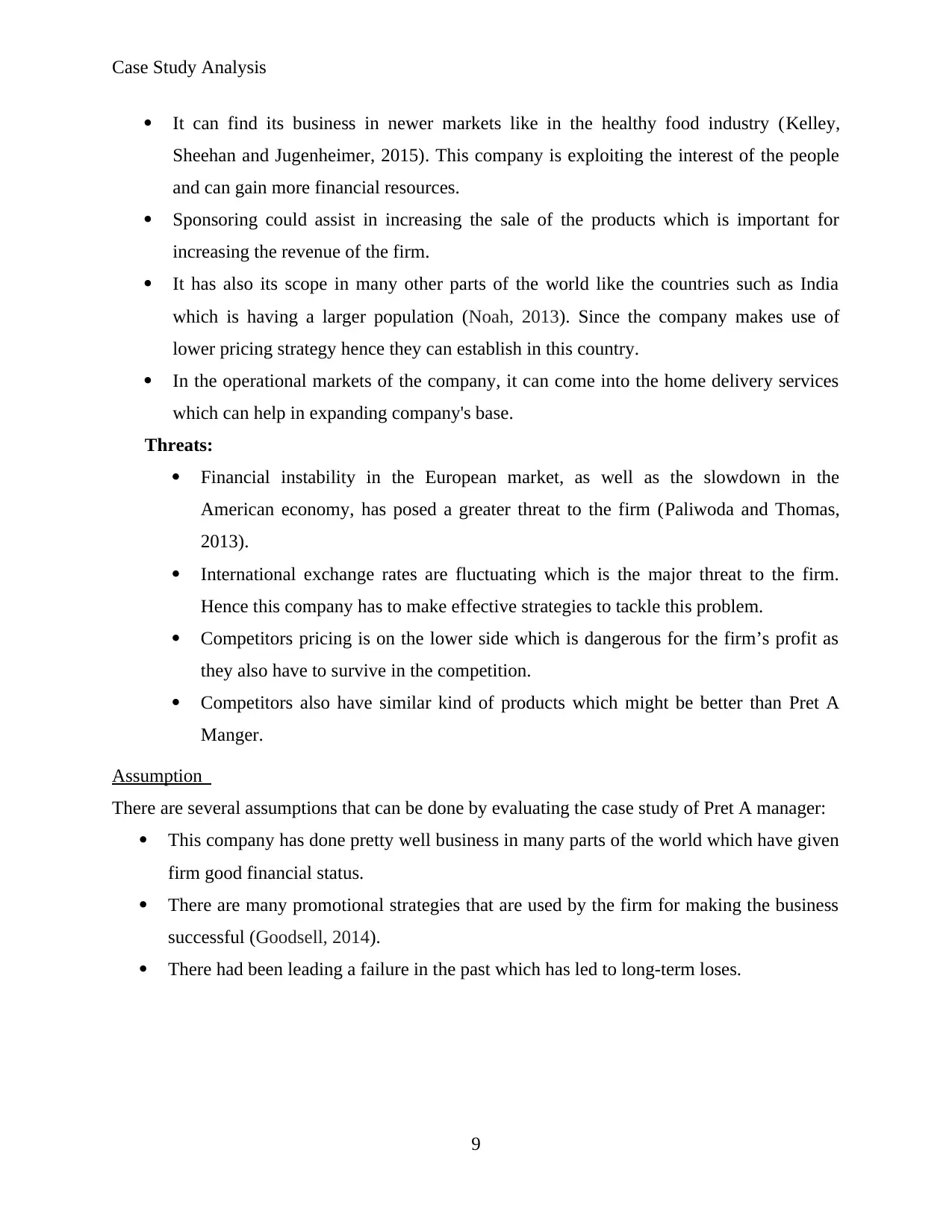
Case Study Analysis
It can find its business in newer markets like in the healthy food industry (Kelley,
Sheehan and Jugenheimer, 2015). This company is exploiting the interest of the people
and can gain more financial resources.
Sponsoring could assist in increasing the sale of the products which is important for
increasing the revenue of the firm.
It has also its scope in many other parts of the world like the countries such as India
which is having a larger population (Noah, 2013). Since the company makes use of
lower pricing strategy hence they can establish in this country.
In the operational markets of the company, it can come into the home delivery services
which can help in expanding company's base.
Threats:
Financial instability in the European market, as well as the slowdown in the
American economy, has posed a greater threat to the firm (Paliwoda and Thomas,
2013).
International exchange rates are fluctuating which is the major threat to the firm.
Hence this company has to make effective strategies to tackle this problem.
Competitors pricing is on the lower side which is dangerous for the firm’s profit as
they also have to survive in the competition.
Competitors also have similar kind of products which might be better than Pret A
Manger.
Assumption
There are several assumptions that can be done by evaluating the case study of Pret A manager:
This company has done pretty well business in many parts of the world which have given
firm good financial status.
There are many promotional strategies that are used by the firm for making the business
successful (Goodsell, 2014).
There had been leading a failure in the past which has led to long-term loses.
9
It can find its business in newer markets like in the healthy food industry (Kelley,
Sheehan and Jugenheimer, 2015). This company is exploiting the interest of the people
and can gain more financial resources.
Sponsoring could assist in increasing the sale of the products which is important for
increasing the revenue of the firm.
It has also its scope in many other parts of the world like the countries such as India
which is having a larger population (Noah, 2013). Since the company makes use of
lower pricing strategy hence they can establish in this country.
In the operational markets of the company, it can come into the home delivery services
which can help in expanding company's base.
Threats:
Financial instability in the European market, as well as the slowdown in the
American economy, has posed a greater threat to the firm (Paliwoda and Thomas,
2013).
International exchange rates are fluctuating which is the major threat to the firm.
Hence this company has to make effective strategies to tackle this problem.
Competitors pricing is on the lower side which is dangerous for the firm’s profit as
they also have to survive in the competition.
Competitors also have similar kind of products which might be better than Pret A
Manger.
Assumption
There are several assumptions that can be done by evaluating the case study of Pret A manager:
This company has done pretty well business in many parts of the world which have given
firm good financial status.
There are many promotional strategies that are used by the firm for making the business
successful (Goodsell, 2014).
There had been leading a failure in the past which has led to long-term loses.
9
⊘ This is a preview!⊘
Do you want full access?
Subscribe today to unlock all pages.

Trusted by 1+ million students worldwide
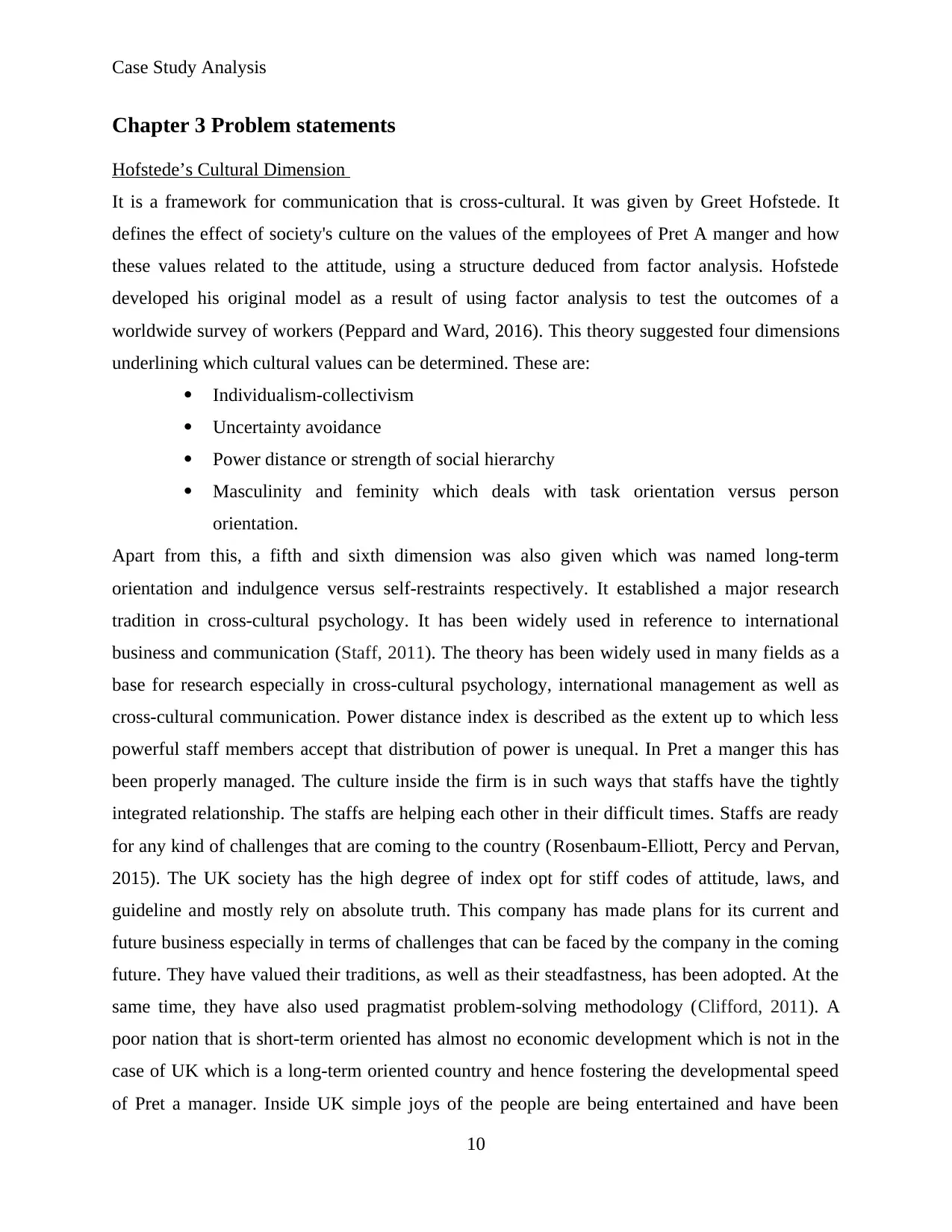
Case Study Analysis
Chapter 3 Problem statements
Hofstede’s Cultural Dimension
It is a framework for communication that is cross-cultural. It was given by Greet Hofstede. It
defines the effect of society's culture on the values of the employees of Pret A manger and how
these values related to the attitude, using a structure deduced from factor analysis. Hofstede
developed his original model as a result of using factor analysis to test the outcomes of a
worldwide survey of workers (Peppard and Ward, 2016). This theory suggested four dimensions
underlining which cultural values can be determined. These are:
Individualism-collectivism
Uncertainty avoidance
Power distance or strength of social hierarchy
Masculinity and feminity which deals with task orientation versus person
orientation.
Apart from this, a fifth and sixth dimension was also given which was named long-term
orientation and indulgence versus self-restraints respectively. It established a major research
tradition in cross-cultural psychology. It has been widely used in reference to international
business and communication (Staff, 2011). The theory has been widely used in many fields as a
base for research especially in cross-cultural psychology, international management as well as
cross-cultural communication. Power distance index is described as the extent up to which less
powerful staff members accept that distribution of power is unequal. In Pret a manger this has
been properly managed. The culture inside the firm is in such ways that staffs have the tightly
integrated relationship. The staffs are helping each other in their difficult times. Staffs are ready
for any kind of challenges that are coming to the country (Rosenbaum-Elliott, Percy and Pervan,
2015). The UK society has the high degree of index opt for stiff codes of attitude, laws, and
guideline and mostly rely on absolute truth. This company has made plans for its current and
future business especially in terms of challenges that can be faced by the company in the coming
future. They have valued their traditions, as well as their steadfastness, has been adopted. At the
same time, they have also used pragmatist problem-solving methodology (Clifford, 2011). A
poor nation that is short-term oriented has almost no economic development which is not in the
case of UK which is a long-term oriented country and hence fostering the developmental speed
of Pret a manager. Inside UK simple joys of the people are being entertained and have been
10
Chapter 3 Problem statements
Hofstede’s Cultural Dimension
It is a framework for communication that is cross-cultural. It was given by Greet Hofstede. It
defines the effect of society's culture on the values of the employees of Pret A manger and how
these values related to the attitude, using a structure deduced from factor analysis. Hofstede
developed his original model as a result of using factor analysis to test the outcomes of a
worldwide survey of workers (Peppard and Ward, 2016). This theory suggested four dimensions
underlining which cultural values can be determined. These are:
Individualism-collectivism
Uncertainty avoidance
Power distance or strength of social hierarchy
Masculinity and feminity which deals with task orientation versus person
orientation.
Apart from this, a fifth and sixth dimension was also given which was named long-term
orientation and indulgence versus self-restraints respectively. It established a major research
tradition in cross-cultural psychology. It has been widely used in reference to international
business and communication (Staff, 2011). The theory has been widely used in many fields as a
base for research especially in cross-cultural psychology, international management as well as
cross-cultural communication. Power distance index is described as the extent up to which less
powerful staff members accept that distribution of power is unequal. In Pret a manger this has
been properly managed. The culture inside the firm is in such ways that staffs have the tightly
integrated relationship. The staffs are helping each other in their difficult times. Staffs are ready
for any kind of challenges that are coming to the country (Rosenbaum-Elliott, Percy and Pervan,
2015). The UK society has the high degree of index opt for stiff codes of attitude, laws, and
guideline and mostly rely on absolute truth. This company has made plans for its current and
future business especially in terms of challenges that can be faced by the company in the coming
future. They have valued their traditions, as well as their steadfastness, has been adopted. At the
same time, they have also used pragmatist problem-solving methodology (Clifford, 2011). A
poor nation that is short-term oriented has almost no economic development which is not in the
case of UK which is a long-term oriented country and hence fostering the developmental speed
of Pret a manager. Inside UK simple joys of the people are being entertained and have been
10
Paraphrase This Document
Need a fresh take? Get an instant paraphrase of this document with our AI Paraphraser
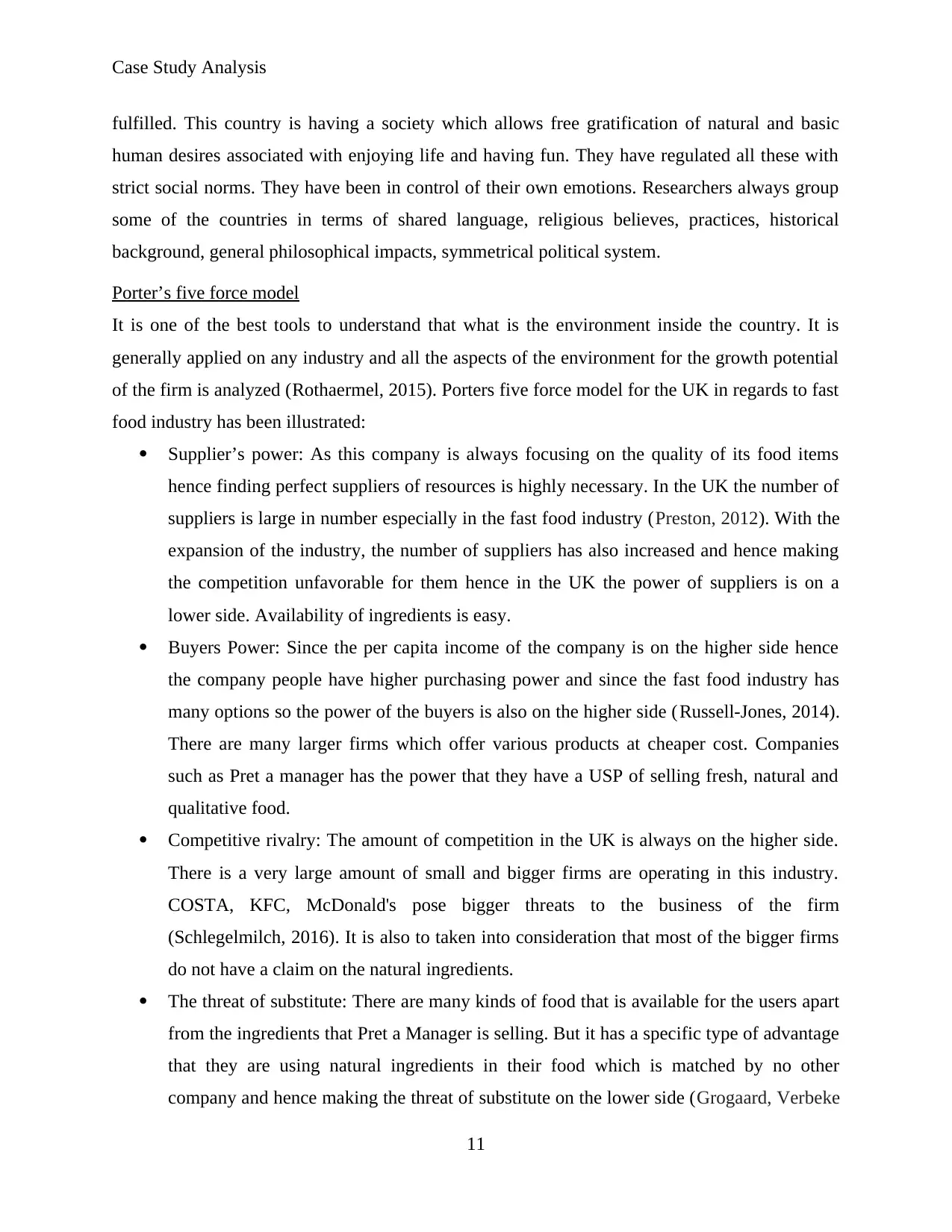
Case Study Analysis
fulfilled. This country is having a society which allows free gratification of natural and basic
human desires associated with enjoying life and having fun. They have regulated all these with
strict social norms. They have been in control of their own emotions. Researchers always group
some of the countries in terms of shared language, religious believes, practices, historical
background, general philosophical impacts, symmetrical political system.
Porter’s five force model
It is one of the best tools to understand that what is the environment inside the country. It is
generally applied on any industry and all the aspects of the environment for the growth potential
of the firm is analyzed (Rothaermel, 2015). Porters five force model for the UK in regards to fast
food industry has been illustrated:
Supplier’s power: As this company is always focusing on the quality of its food items
hence finding perfect suppliers of resources is highly necessary. In the UK the number of
suppliers is large in number especially in the fast food industry (Preston, 2012). With the
expansion of the industry, the number of suppliers has also increased and hence making
the competition unfavorable for them hence in the UK the power of suppliers is on a
lower side. Availability of ingredients is easy.
Buyers Power: Since the per capita income of the company is on the higher side hence
the company people have higher purchasing power and since the fast food industry has
many options so the power of the buyers is also on the higher side (Russell-Jones, 2014).
There are many larger firms which offer various products at cheaper cost. Companies
such as Pret a manager has the power that they have a USP of selling fresh, natural and
qualitative food.
Competitive rivalry: The amount of competition in the UK is always on the higher side.
There is a very large amount of small and bigger firms are operating in this industry.
COSTA, KFC, McDonald's pose bigger threats to the business of the firm
(Schlegelmilch, 2016). It is also to taken into consideration that most of the bigger firms
do not have a claim on the natural ingredients.
The threat of substitute: There are many kinds of food that is available for the users apart
from the ingredients that Pret a Manager is selling. But it has a specific type of advantage
that they are using natural ingredients in their food which is matched by no other
company and hence making the threat of substitute on the lower side (Grogaard, Verbeke
11
fulfilled. This country is having a society which allows free gratification of natural and basic
human desires associated with enjoying life and having fun. They have regulated all these with
strict social norms. They have been in control of their own emotions. Researchers always group
some of the countries in terms of shared language, religious believes, practices, historical
background, general philosophical impacts, symmetrical political system.
Porter’s five force model
It is one of the best tools to understand that what is the environment inside the country. It is
generally applied on any industry and all the aspects of the environment for the growth potential
of the firm is analyzed (Rothaermel, 2015). Porters five force model for the UK in regards to fast
food industry has been illustrated:
Supplier’s power: As this company is always focusing on the quality of its food items
hence finding perfect suppliers of resources is highly necessary. In the UK the number of
suppliers is large in number especially in the fast food industry (Preston, 2012). With the
expansion of the industry, the number of suppliers has also increased and hence making
the competition unfavorable for them hence in the UK the power of suppliers is on a
lower side. Availability of ingredients is easy.
Buyers Power: Since the per capita income of the company is on the higher side hence
the company people have higher purchasing power and since the fast food industry has
many options so the power of the buyers is also on the higher side (Russell-Jones, 2014).
There are many larger firms which offer various products at cheaper cost. Companies
such as Pret a manager has the power that they have a USP of selling fresh, natural and
qualitative food.
Competitive rivalry: The amount of competition in the UK is always on the higher side.
There is a very large amount of small and bigger firms are operating in this industry.
COSTA, KFC, McDonald's pose bigger threats to the business of the firm
(Schlegelmilch, 2016). It is also to taken into consideration that most of the bigger firms
do not have a claim on the natural ingredients.
The threat of substitute: There are many kinds of food that is available for the users apart
from the ingredients that Pret a Manager is selling. But it has a specific type of advantage
that they are using natural ingredients in their food which is matched by no other
company and hence making the threat of substitute on the lower side (Grogaard, Verbeke
11
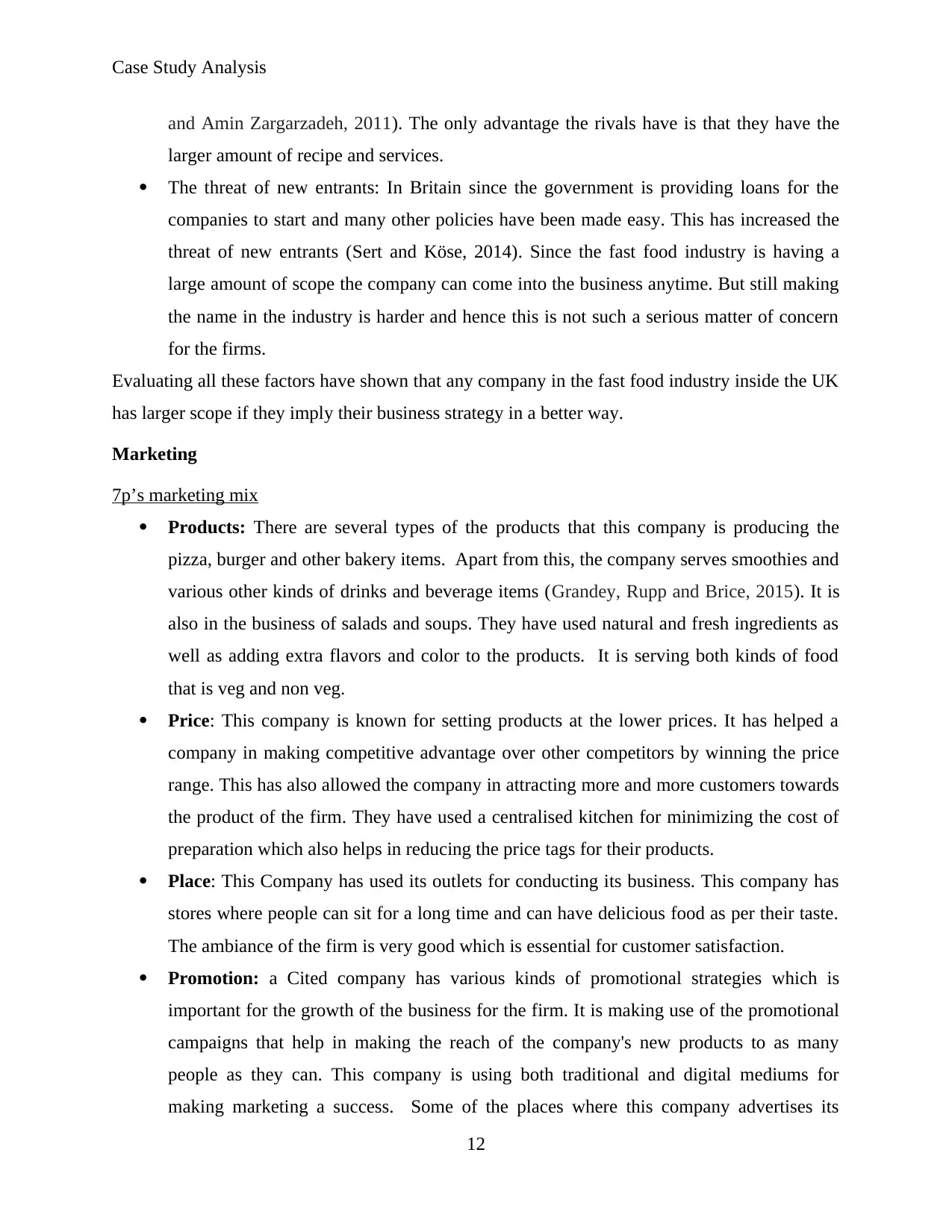
Case Study Analysis
and Amin Zargarzadeh, 2011). The only advantage the rivals have is that they have the
larger amount of recipe and services.
The threat of new entrants: In Britain since the government is providing loans for the
companies to start and many other policies have been made easy. This has increased the
threat of new entrants (Sert and Köse, 2014). Since the fast food industry is having a
large amount of scope the company can come into the business anytime. But still making
the name in the industry is harder and hence this is not such a serious matter of concern
for the firms.
Evaluating all these factors have shown that any company in the fast food industry inside the UK
has larger scope if they imply their business strategy in a better way.
Marketing
7p’s marketing mix
Products: There are several types of the products that this company is producing the
pizza, burger and other bakery items. Apart from this, the company serves smoothies and
various other kinds of drinks and beverage items (Grandey, Rupp and Brice, 2015). It is
also in the business of salads and soups. They have used natural and fresh ingredients as
well as adding extra flavors and color to the products. It is serving both kinds of food
that is veg and non veg.
Price: This company is known for setting products at the lower prices. It has helped a
company in making competitive advantage over other competitors by winning the price
range. This has also allowed the company in attracting more and more customers towards
the product of the firm. They have used a centralised kitchen for minimizing the cost of
preparation which also helps in reducing the price tags for their products.
Place: This Company has used its outlets for conducting its business. This company has
stores where people can sit for a long time and can have delicious food as per their taste.
The ambiance of the firm is very good which is essential for customer satisfaction.
Promotion: a Cited company has various kinds of promotional strategies which is
important for the growth of the business for the firm. It is making use of the promotional
campaigns that help in making the reach of the company's new products to as many
people as they can. This company is using both traditional and digital mediums for
making marketing a success. Some of the places where this company advertises its
12
and Amin Zargarzadeh, 2011). The only advantage the rivals have is that they have the
larger amount of recipe and services.
The threat of new entrants: In Britain since the government is providing loans for the
companies to start and many other policies have been made easy. This has increased the
threat of new entrants (Sert and Köse, 2014). Since the fast food industry is having a
large amount of scope the company can come into the business anytime. But still making
the name in the industry is harder and hence this is not such a serious matter of concern
for the firms.
Evaluating all these factors have shown that any company in the fast food industry inside the UK
has larger scope if they imply their business strategy in a better way.
Marketing
7p’s marketing mix
Products: There are several types of the products that this company is producing the
pizza, burger and other bakery items. Apart from this, the company serves smoothies and
various other kinds of drinks and beverage items (Grandey, Rupp and Brice, 2015). It is
also in the business of salads and soups. They have used natural and fresh ingredients as
well as adding extra flavors and color to the products. It is serving both kinds of food
that is veg and non veg.
Price: This company is known for setting products at the lower prices. It has helped a
company in making competitive advantage over other competitors by winning the price
range. This has also allowed the company in attracting more and more customers towards
the product of the firm. They have used a centralised kitchen for minimizing the cost of
preparation which also helps in reducing the price tags for their products.
Place: This Company has used its outlets for conducting its business. This company has
stores where people can sit for a long time and can have delicious food as per their taste.
The ambiance of the firm is very good which is essential for customer satisfaction.
Promotion: a Cited company has various kinds of promotional strategies which is
important for the growth of the business for the firm. It is making use of the promotional
campaigns that help in making the reach of the company's new products to as many
people as they can. This company is using both traditional and digital mediums for
making marketing a success. Some of the places where this company advertises its
12
⊘ This is a preview!⊘
Do you want full access?
Subscribe today to unlock all pages.

Trusted by 1+ million students worldwide
1 out of 23
Related Documents
Your All-in-One AI-Powered Toolkit for Academic Success.
+13062052269
info@desklib.com
Available 24*7 on WhatsApp / Email
![[object Object]](/_next/static/media/star-bottom.7253800d.svg)
Unlock your academic potential
Copyright © 2020–2025 A2Z Services. All Rights Reserved. Developed and managed by ZUCOL.




